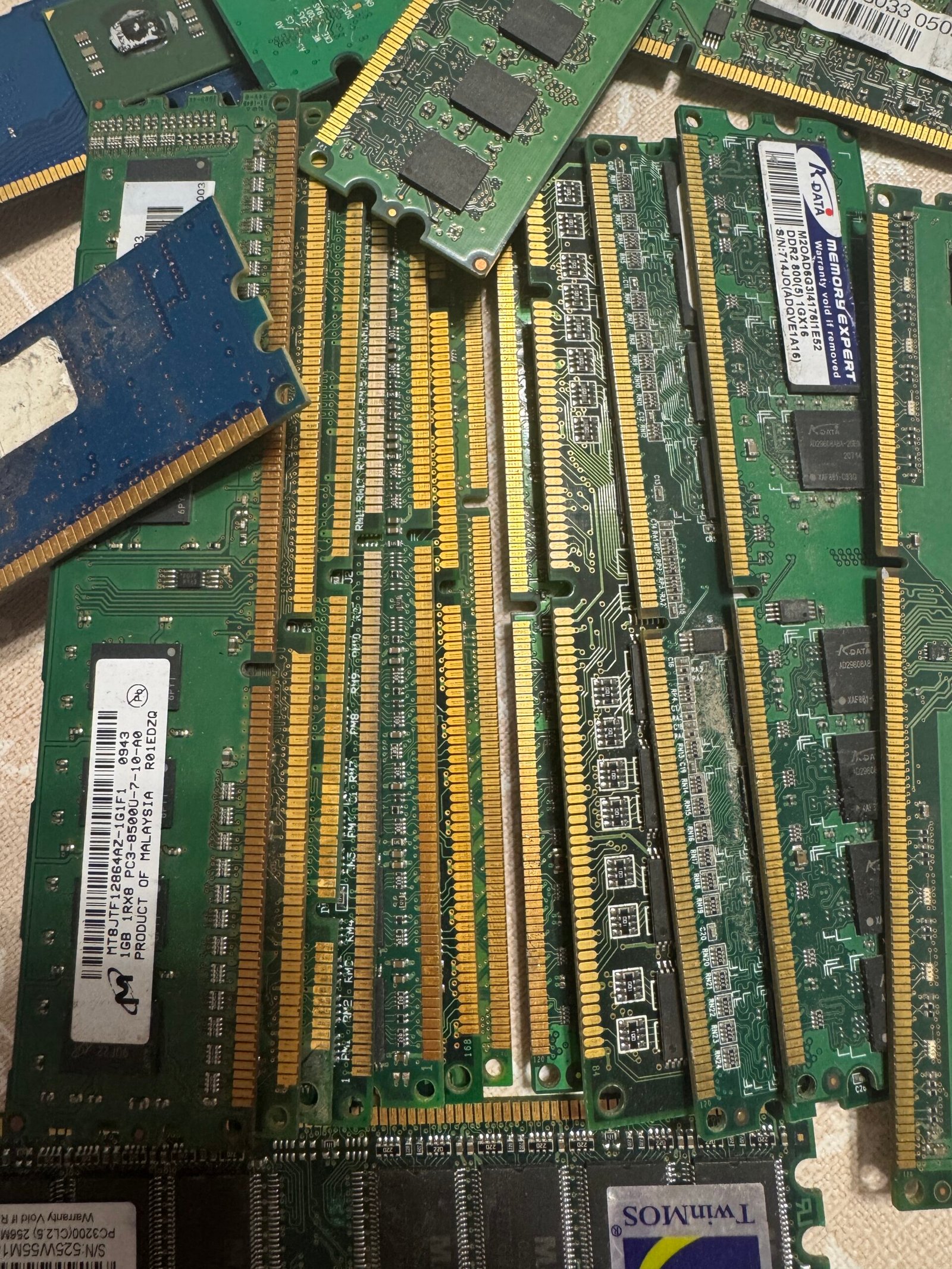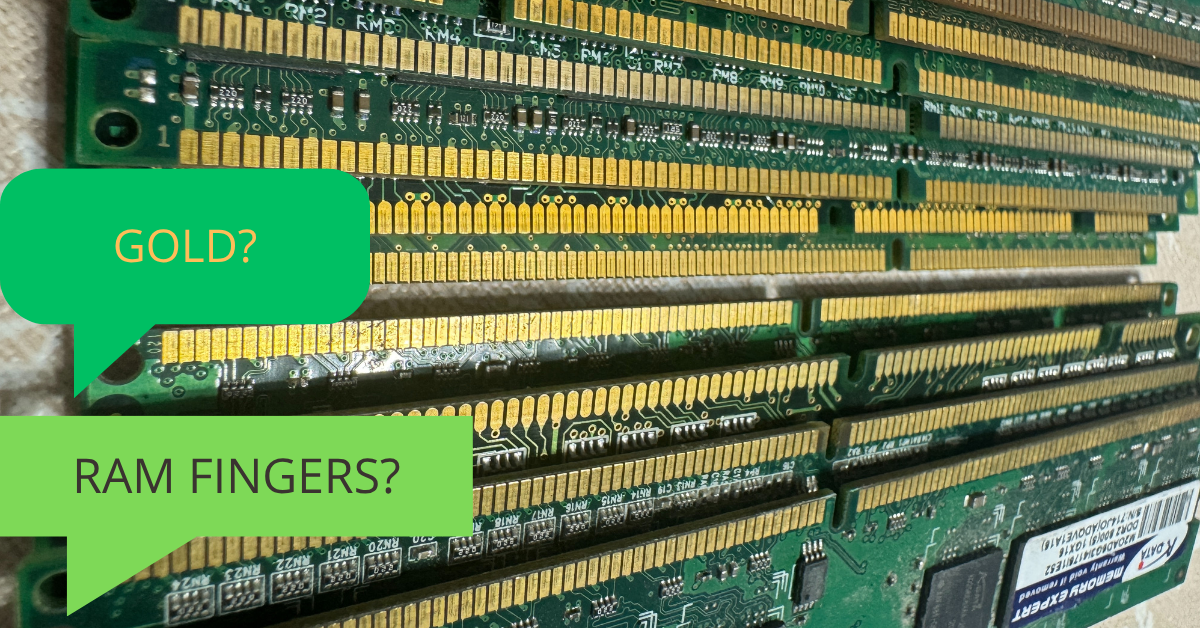Among the many hidden treasures inside old computers, few parts attract as much curiosity as RAM fingers. These gold-plated connectors at the bottom of memory sticks are a small but eye-catching example of how precious metals are used in everyday electronics.
Sometimes sold separately as trimmed RAM fingers, they are one of the most recognizable forms of gold plated electronic scrap. While the gold content is thin, RAM fingers are highly valued in both recycling industries and hobbyist communities. They bridge two worlds: professional gold recovery from electronic waste and the more personal satisfaction of collecting and experimenting with computer scrap.
This article explores what RAM fingers are, why they are gold-plated, how they are separated, and what role they play in the broader story of gold computer scrap.
What is RAM?
Random Access Memory (RAM) is the short-term memory of a computer, responsible for temporarily storing data that the processor needs immediately. Unlike hard drives or SSDs, RAM is volatile – its contents disappear once the computer is powered off.
Over the decades, RAM modules have taken many forms, from early DIP chips to modern DIMMs. Yet all have one thing in common: they must connect securely to the motherboard. This is where RAM fingers come in.
What Are RAM Fingers?
RAM fingers are the metallic contacts that line the bottom edge of a RAM stick. Their job is simple but essential: to ensure a stable connection between the RAM module and the computer’s motherboard.
When RAM modules are recycled, these connectors are often cut off and collected separately. In the scrap trade, these pieces are called trimmed RAM fingers. They are sorted into bags or containers, making them easier to handle, weigh, and sell as gold plated electronic scrap.
Collectors, recyclers, and hobbyists alike recognize trimmed RAM fingers as one of the most familiar types of gold computer scrap.
Why Are RAM Fingers Gold-Plated?
Gold may sound luxurious, but in electronics it is used for a very practical reason. Gold is:
-
A superb conductor – ensuring smooth data transfer.
-
Corrosion-resistant – it does not tarnish like copper or silver.
-
Durable under wear – ideal for connectors that may be inserted or removed many times.
The plating is only a few microns thick, but enough to make a difference. Manufacturers learned long ago that gold connectors were worth the cost to guarantee long-term reliability.
For recyclers, this thin plating is what makes RAM fingers valuable as part of the broader stream of gold from electronic waste.
Why Are RAM Fingers Trimmed and Collected?
When old memory modules are recycled, trimming off the connector section helps concentrate the most valuable part. Instead of dealing with the full module, recyclers and sellers can offer trimmed RAM fingers in bulk.
This practice benefits both sides:
-
Recyclers prefer sorted, consistent material.
-
Hobbyists find trimmed RAM fingers easier to purchase and experiment with.
Thus, what began as a recycling convenience has become its own niche in the world of gold plated electronic scrap.
How Do RAM Fingers Look?
Visually, RAM fingers are easy to recognize. They appear as narrow golden strips at the bottom edge of a RAM module. When cut away, they form small rectangles with shiny gold lines.
Bags of trimmed RAM fingers are a common sight in scrap markets. Their uniform look makes them appealing not only to industrial recyclers but also to enthusiasts who enjoy collecting and studying the materials that once powered our computers.

How Many RAM Chips for 1 Gram of Gold?
A question that often arises is: “How many RAM chips does it take to get 1 gram of gold?”
The exact answer depends on the era, manufacturer, and design of the modules. Older sticks often had slightly thicker gold plating, while modern ones use less. Still, most estimates suggest it can take hundreds, if not thousands, of RAM modules to equal just one gram of gold.
For large-scale recycling companies, this adds up quickly when processing tons of gold computer scrap. For hobbyists, the numbers may seem small, but many still find enjoyment in collecting, weighing, and even selling trimmed RAM fingers as a way to engage with the fascinating world of gold recovery.
Instead of being discouraged by the thin plating, many collectors see it as a challenge – a reminder that value can be found even in the smallest details of electronic waste.
Gold Recovery and Electronic Waste
The story of RAM fingers is part of the much larger issue of gold from electronic waste. Every year, millions of tons of old computers, smartphones, and other devices are discarded. Within them are tiny amounts of precious metals: gold, silver, palladium, and copper.
By recovering these metals, we reduce the need for new mining – a process that is both expensive and environmentally damaging. Gold recovery through recycling turns yesterday’s obsolete hardware into tomorrow’s valuable resources.
For many individuals, selling or collecting gold plated electronic scrap is a way to participate in this cycle. Whether through hobbyist projects, resale, or direct recycling, trimmed RAM fingers become part of a global effort to manage e-waste responsibly.
Why Recycling and Collecting Both Matter
It is true that the most efficient gold recovery happens in industrial facilities. These plants have the equipment and safety systems to process electronic waste at scale.
But this does not mean individuals have no role to play. By collecting, selling, or reusing RAM fingers and other gold computer scrap, hobbyists help keep valuable materials out of landfills. Every small contribution supports the bigger picture of sustainability.
Some buyers look for trimmed RAM fingers specifically because they are easier to process, while others enjoy adding them to their collections of vintage computing materials. In both cases, the result is positive: less waste, more recovery, and a deeper appreciation of the hidden value inside old electronics.
Conclusion
RAM fingers may seem like tiny golden strips, but they carry a larger story. They represent the marriage of technology and precious metals, designed for performance yet destined to become a key part of gold plated electronic scrap.
While it may take hundreds of RAM chips to yield just a gram of gold, trimmed RAM fingers still hold significant value – both as a recycling material and as a collectible form of computer scrap.
For recyclers, they are a concentrated source of gold from electronic waste. For enthusiasts, they are a tangible way to engage with the fascinating world of electronics and precious metals.
Whether sold, collected, or passed along to proper recycling channels, RAM fingers prove that even the smallest details of our computers can play a role in sustainability, recovery, and appreciation of technology’s hidden value.
If you are interested in buying trimmed RAM fingers like the ones in the photo, check out our gold fingers listing here.
Looking for more types of gold plated electronic scrap? Visit our gold scrap section.
